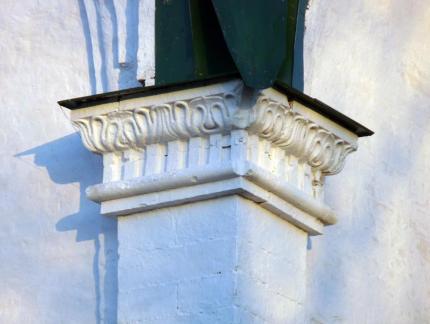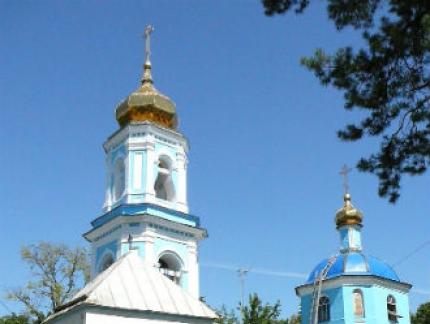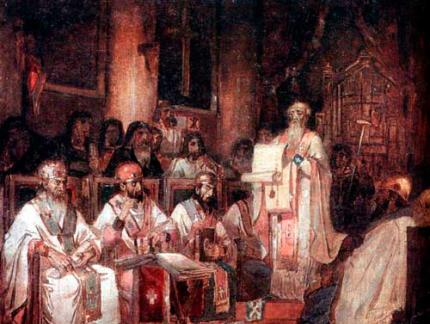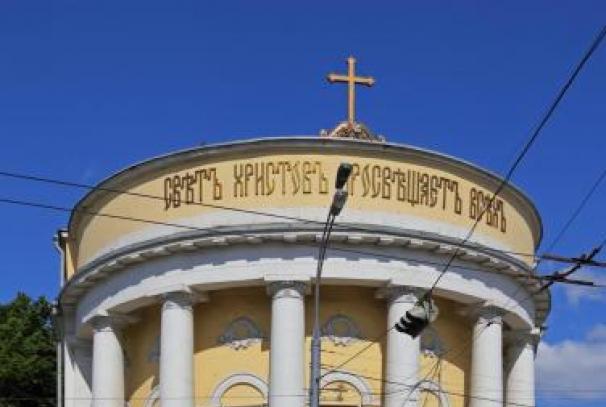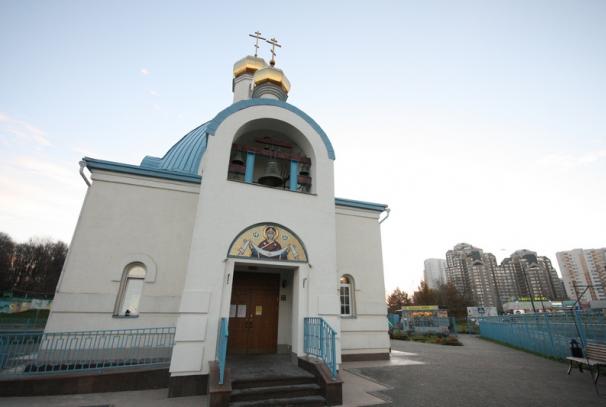St. Andrew's Cathedral. Construction of a wooden St. Andrew's Church
St. Andrew's Cathedral is one of the oldest and most revered temples of St. Petersburg. Located on Vasilyevsky Island. Monument of architecture of the 18th century.
In the second decade of the 18th century, the administrative and business center of the city was moved from Hare Island to Vasilyevsky. Peter I wanted a church dedicated to St. Andrew the First-Called here in front of the Twelve Colleges. But it was built after the death of the emperor.
In 1728, on Vasilievsky Island, at the intersection of Bolshoi Prospekt and Line 6, a plot of land was allocated, where a wooden church was erected. Presumably, the author of the project was D.A. Trezzini. In 1732, the church was consecrated in the name of St. Apostle Andrew the First-Called. The iconostasis from the dilapidated wooden church of the Nativity of the Blessed Virgin Mary, located in Posadskaya Sloboda, on Petersburg Island, was moved here. Empress Anna Ioannovna donated funds for utensils and vestments. The temple was intended for the celebration and celebration of the gentlemen of the Order of St. Andrew. In 1744, he received the status of a cathedral.
The royal family came to the solemn church services, as well as many famous personalities of that time, including M. Lomonosov and V. Trediakovsky. The wooden temple building was cold and cramped, with a 1st aisle and did not differ in beauty. Therefore, in the years 1740-1745 the construction of a new church began on the project of Trezzini. The consecration ceremony in honor of the Three Ecumenical Hierarchs took place in 1760. The iconostasis, the throne, and other utensils were transferred from the former house church of Prince Menshikov.
During a thunderstorm in July 1761, the wooden Andreevsky church burned down, and in the summer of 1764 a new church was built, which was built under the leadership of A. Vista. It has survived to our time. Only in 1780 the construction was completed. The new temple was the center of the Knights of the Order of the Holy Apostle Andrew the First-Called. In 1786 a bell tower was erected, and after 4 years - a chapel. In 1797, a bas-relief depicting the Order of St. Andrew the First-Called, which is in the hands of two angels, was erected above the entrance. In the second half of the 19th century, a parish charity society operated at the cathedral, containing a shelter for children and terminally ill people, cheap housing for women.
After 1917, the temple was looted and closed. It was used as a warehouse. The chapel on the Nikolaev (Blagoveshchensk) bridge, due to the installation of a monument to Lieutenant P.P. Schmidt, destroyed. In 1928, the bells were removed from the bell tower, and subsequently they were melted down. In the war years of the Great Patriotic War, the roof, facades, iconostasis, and the interior of the church suffered.
In 1992, the cathedral was restored and returned to the parishioners. Services are held daily.
The graceful cathedral building is painted in pale pink. The high dome of the temple and the slender bell tower are admirable. The cathedral is crowned with the 1st large and four small domes. The architectural style can be described as a transition from baroque to classicism.
The best decoration of the cathedral is a three-tier carved gilded iconostasis. Its height is 17 meters. Among other values \u200b\u200bcan be noted altar silver vestments weighing 115 kg in the main altar, the gospel in a silver setting, the icon of the Exaltation, the altarpiece of the Lord of hosts.
There is a legend that near the church Ekaterina Alekseevna Dolgorukaya (“the failed empress”) was buried, who was the bride of the young emperor Peter II, who died of smallpox on the eve of the wedding.
St. Andrew's Cathedral on Vasilyevsky Island includes several buildings: cathedral of St. Andrewlocated nearby temple of Three Ecumenical Saints, and chapel of St. Equal-to-the-Apostles Grand Duke Vladimir. The first two churches, despite the lack of rich decoration characteristic of many large cathedrals of the city, have a long history dating back to Peter I, and are especially revered by the parishioners of St. Petersburg.
Considering the Apostle Andrew as his heavenly patron, Peter the Great planned to build a church at the Twelve Colleges (today the main building of St. Petersburg State University) on the Spit of Vasilyevsky Island. Only the sudden death of the emperor prevented the transition from the paper stage of the project to its implementation. As a result, the wooden church is already under design Domenico Trezzini It was built only in 1731. Due to the small capacity of the church and the lack of heating, later, in 1745, a small stone church was erected in the neighborhood (located to the left of St. Andrew's Cathedral), called the Three Ecumenical Saints (architect Domenico Trezzini). Then, by the way, in the church, Mikhailo Lomonosov and Vasily Trediakovsky took the oath as professors of the St. Petersburg Academy of Sciences.
In 1764, the wooden cathedral burned down, and in its place began the construction of a modern building designed by the architect A.F. Vista. Over the next 30 years, a bell tower and a chapel were completed. Under Paul I, the cathedral was assigned the status Order Church of St. Andrew the First-Called; so a cartouche appeared with two angels above the entrance, bearing the sign of the Apostle Andrew. Under the new rules in the cathedral, on the day of the patron saint of the order, his cavaliers were to gather for service.
Subsequently, the building was completed (two new aisles) and improved (heating was arranged). In 1878-1879, both churches, St. Andrew and the Three Ecumenical Saints, were united by a common fence. At different times, Ksenia of Petersburg, John of Kronstadt, Emperor Nicholas II and others prayed in them.
Due to its height (45 meters), the cathedral remains the high-rise dominant of Vasilyevsky Island (if you do not take into account the new buildings of recent years in the area of \u200b\u200bthe Kirov Palace of Culture and the Primorskaya metro station). Its elongated turrets around the main dome make the overall composition of the church unusual.
The dome and towers of St. Andrew's Cathedral






It is believed that before the revolution, the collection of ancient Russian icons in the churches of St. Andrew's Cathedral was one of the most significant in St. Petersburg. However, in the years after the revolution, churches were looted, later abandoned and closed in 1938. At different times, the buildings were used for various needs, including as warehouses, premises of the Library of the Academy of Sciences, the Ministry of the Navy, etc. Until the collapse of the Soviet Union, the temple was given to store the funds of the Institute and the Museum of Ethnography of the USSR Academy of Sciences.
The first liturgy after a long (more than 50 years) break in the cathedral was celebrated in 1990. From this moment began the gradual return to the temple of its values \u200b\u200band premises. When work was underway on the 6th and 7th lines of Vasilievsky Island to build a pedestrian zone, a chapel was built on the corner of Bolshoi Prospekt, and an obelisk was erected in honor of the 300th anniversary of the establishment of the highest award of the Russian Empire - the Order of St. Andrew the First-Called.
Obelisk in honor of the 300th anniversary of the Order of St. Andrew







Bust F.A. Golovin
Recently, a monument to the first gentleman of this order, Fedor Alekseevich Golovin, is also located in the square near the St. Andrew’s Cathedral.
 There are 44 icons in the St. Andrew Cathedral. The most revered of them - of course, the holy Apostle Andrew the First-Called. One of the icons is stored with a particle of its relics. We also note the images of the apostles Andrew and Philip. A complete list of icons and their location in the temple can be found at this link on the temple website. The great value of the cathedral is also an old, 18th century, gilded iconostasis 17 meters high. Miraculously surviving in the time of troubles and during the blockade, he is now one of the oldest in the city. Services are held daily in the temple, which anyone can attend.
There are 44 icons in the St. Andrew Cathedral. The most revered of them - of course, the holy Apostle Andrew the First-Called. One of the icons is stored with a particle of its relics. We also note the images of the apostles Andrew and Philip. A complete list of icons and their location in the temple can be found at this link on the temple website. The great value of the cathedral is also an old, 18th century, gilded iconostasis 17 meters high. Miraculously surviving in the time of troubles and during the blockade, he is now one of the oldest in the city. Services are held daily in the temple, which anyone can attend.















Sights of the Northern capital: St. Andrew's Cathedral.
St. Andrew's Cathedral (the official name is the Cathedral of St. Andrew the First-Called) is an active Orthodox cathedral on Vasilyevsky Island in St. Petersburg, located at the intersection of Bolshoi Prospekt and the 6th line, an architectural monument of the 18th century. From St. Andrew's Cathedral comes the name of St. Andrew's Market.
The temple belongs to the St. Petersburg Diocese of the Russian Orthodox Church, is part of the Vasileostrov Deanery District. Rector - Archpriest Michael Mokropolov.
St. Andrew's Church of Vasilyevsky Island is one of the very first cathedrals in St. Petersburg. Interestingly, before its construction, services for the flock of this region were held in the house church of A.D. Menshikov. It was from the Menshikov church that the iconostasis was transferred to the St. Andrew's Church built in 1732.
Actually, the church in this "new and about to become the main district" of St. Petersburg - Vasilievsky Island - was thought from the very beginning of the development of this territory. Peter I planned to erect the temple of A. the First-Called here, but the business was a little suspended after the death of the emperor, and the first wooden church was built according to the design of Trezzini, which is building the Strelka of the island, only by order of Catherine I.
It is interesting that one of the first gentlemen of the Order of St. Andrew the First-Called - the very first order of Russia, established by the great Peter the Great - Count F.M. Apraksin bequeathed a large sum of money to such an affair. Since 1744, St. Andrew's Church becomes a cathedral, and a cemetery is located near it. There is a legend that Prince Y. Dolgoruky, Princess E. Dolgoruky and Peter's associate A. Nartov were buried there. In St. Andrew's Cathedral, the oath was taken by professors V.K.Trediakovsky, M.V. Lomonosov.
During a thunderstorm in 1761, a wooden temple building burns out from a lightning strike. The iconostasis is saved, and since 1763 they begin to raise funds for the construction of a stone building. Empress Catherine and Grand Duke Paul donate significant amounts. However, the misadventures of St. Andrew's Church do not end there. In 1766, a dome collapsed on an almost finished cathedral, the architect A. Vista was arrested, and A. Ivanov was entrusted with the construction. The charges against A. Vista are subsequently dropped (they prove that the fault of the crash was a brick of poor quality), however, the opening of St. Andrew's Cathedral is constantly postponed for technical reasons. It will take place only in 1780, and after 6 years the bell tower will be erected nearby.
Paul I commanded to strengthen the sign of the order over the entrance of the temple, and from 1797 St. Andrew's Cathedral became the order church of A. the First-Called.
In the mid-19th century, the iconostasis was built up on one tier and expanded to donations from merchants Tymenkov and Frolov, and side altars - Nikolsky and Uspensky - were added to the main building.
In the late 70's. The 19th century St. Andrew's Church is combined with the Church of the Three Saints, according to the design of A. Krakau, the chapel is rebuilt and a common fence is being built.
Since the second half of the 19th century, the largest parish charity organization, the Society for Assisting the Poor, has been operating at St. Andrew's Church.
The October Revolution of 1917 entailed the desolation and partial destruction of St. Andrew's Church, and in 1938 its closure altogether. As usual in those years, the premises were used as a production warehouse, then as a repository of the Library of the Academy of Sciences and funds of the Institute and the Museum of Ethnography.
Since 1992, St. Andrew's Church has been restored to its Orthodox status; now services are held here, which can be visited from 9 a.m. to 7 p.m.
Address: 199034, St. Petersburg, Vasilyevsky Island, 6th line, 11
Transport: st. metro station "Vasileostrovskaya"
Phone: 323-34-18
Special thanks for the material provided to My Petersburg Agency - Organization of city tours, hotel reservations.




Gennady Zanegin

